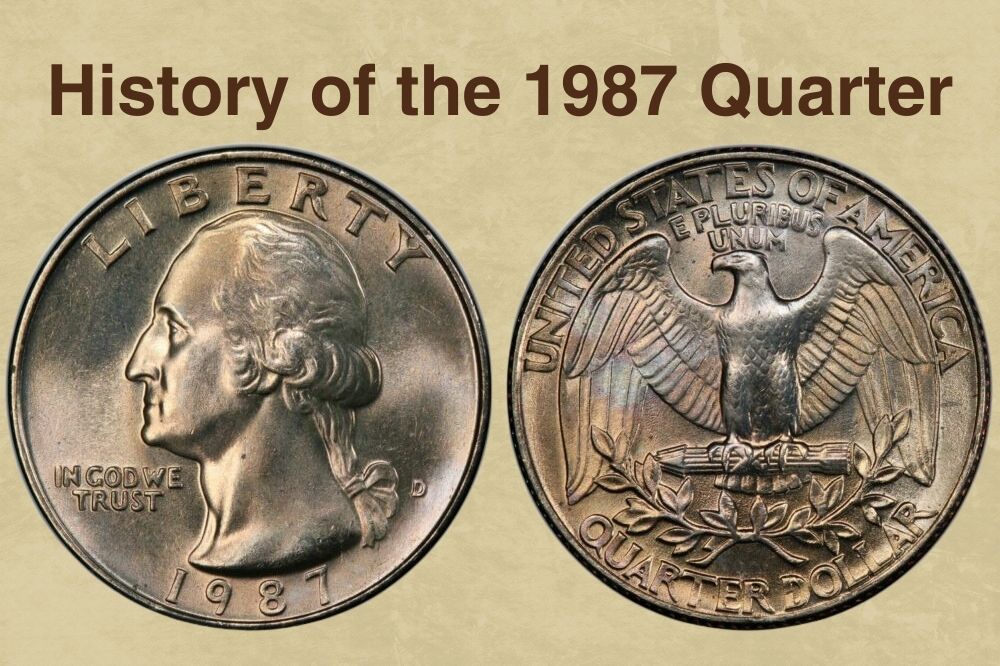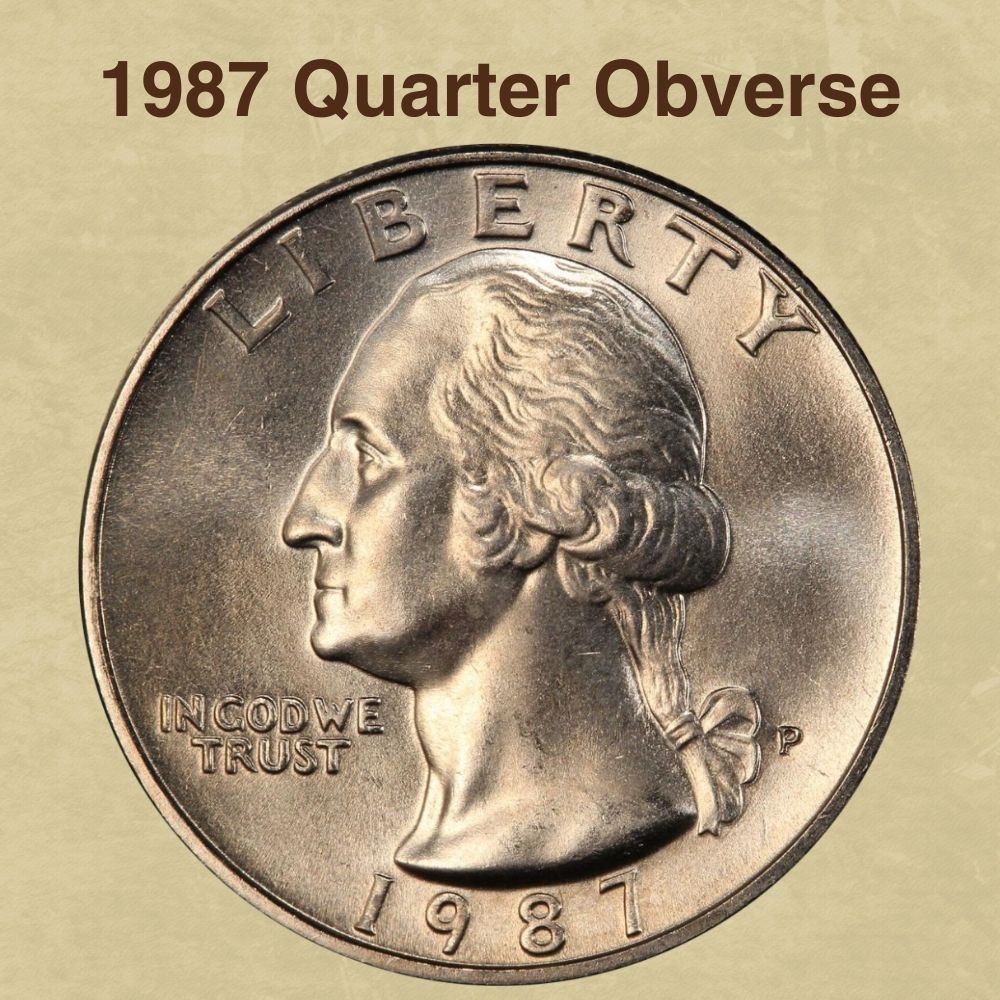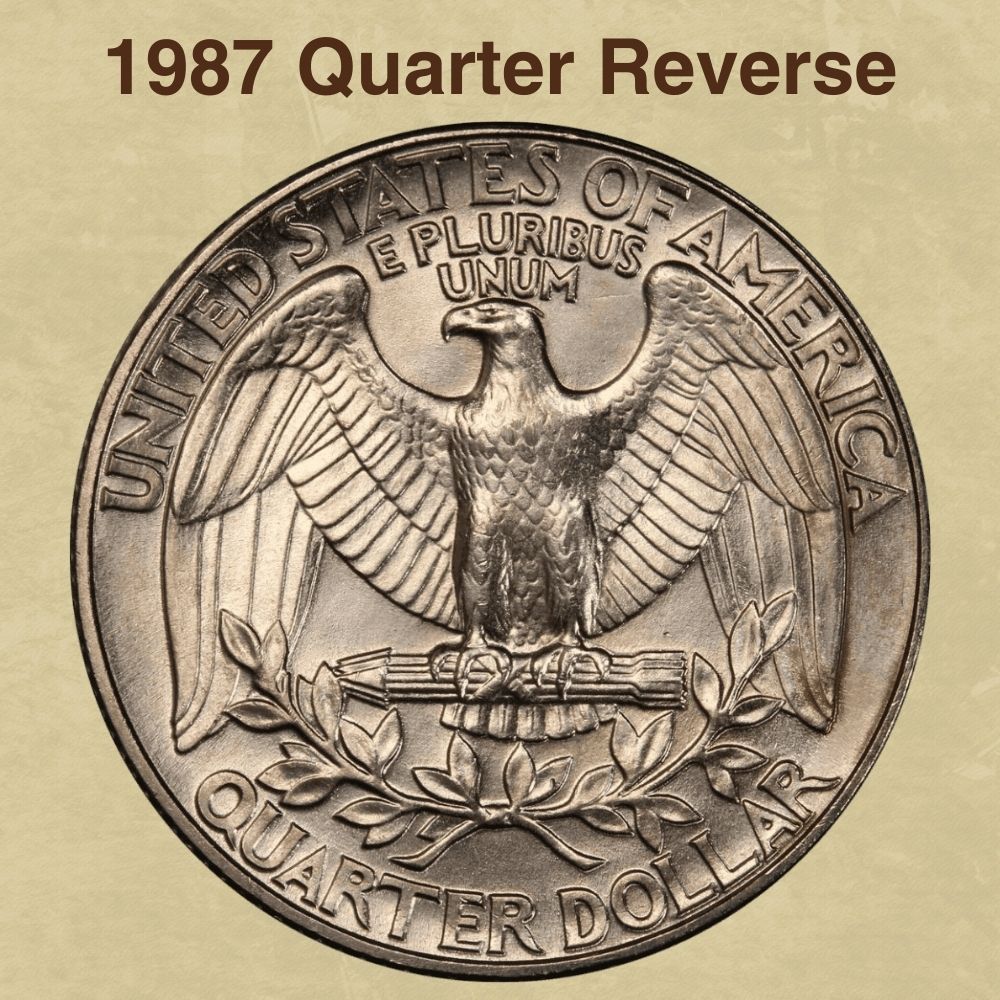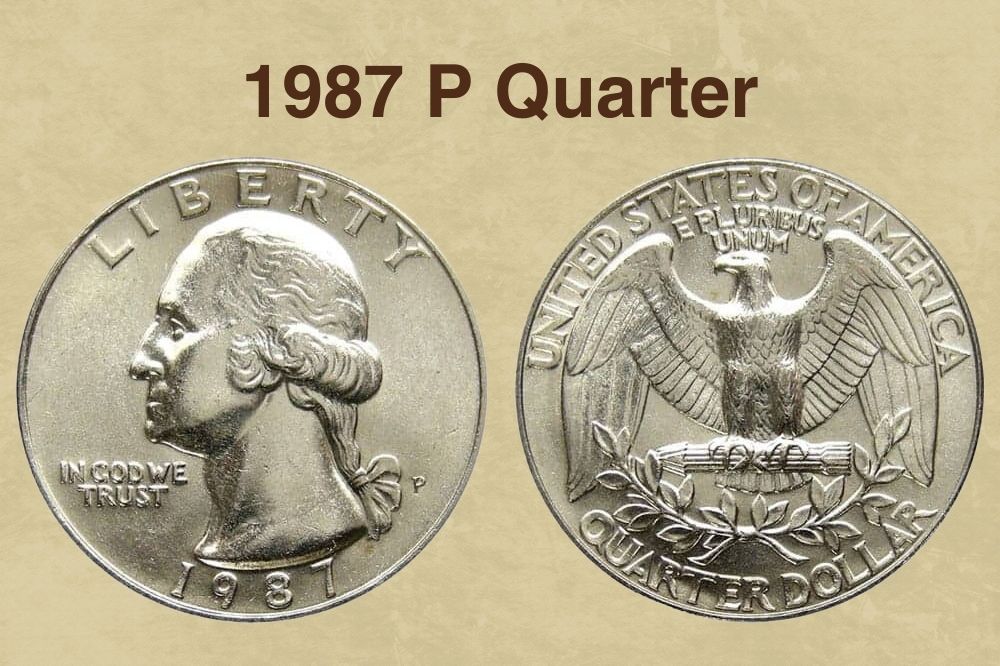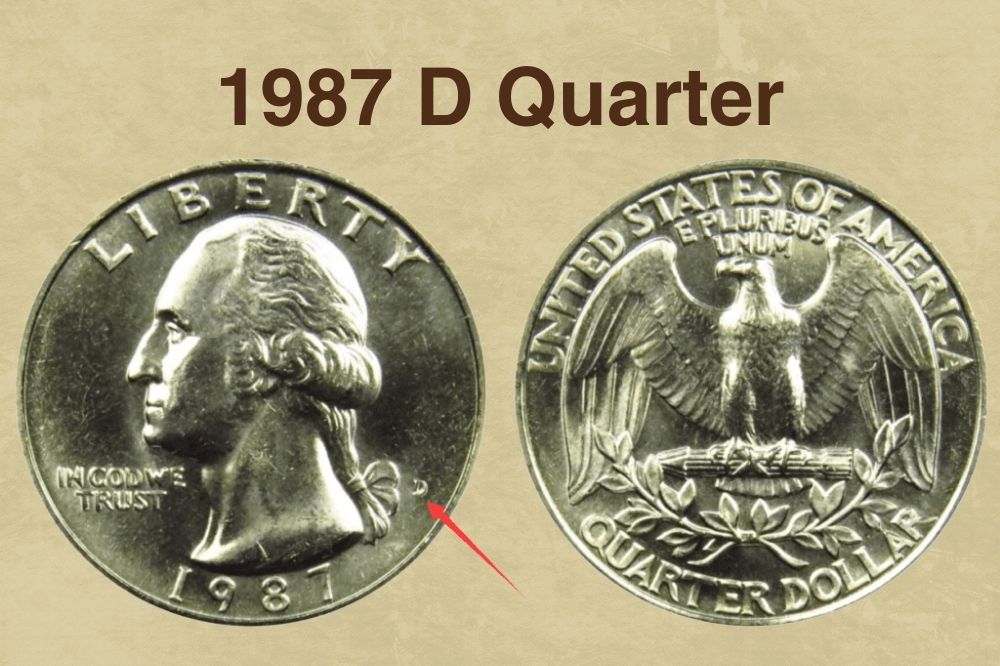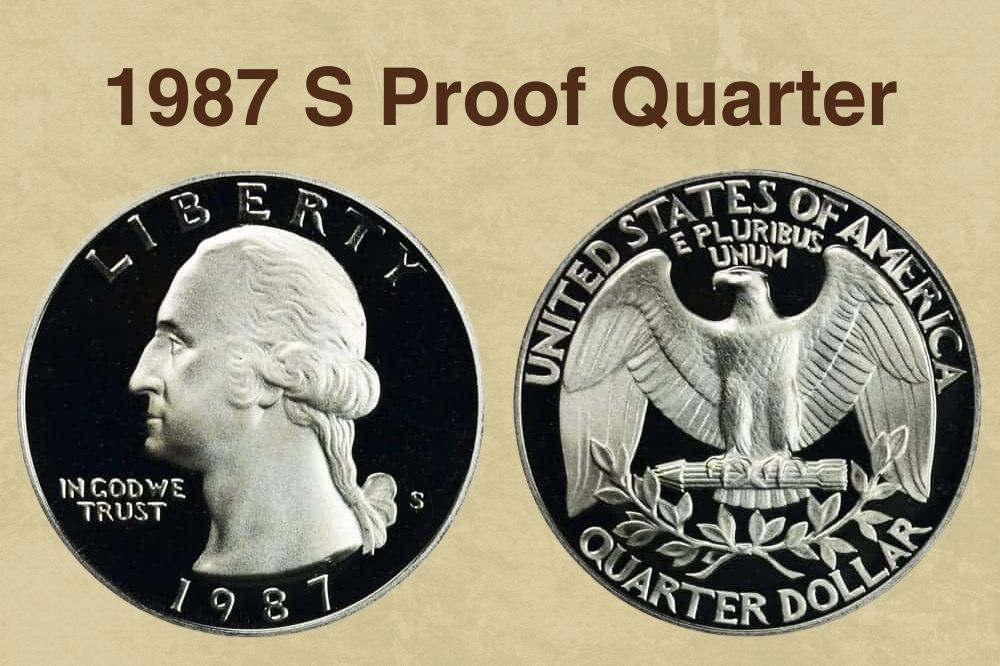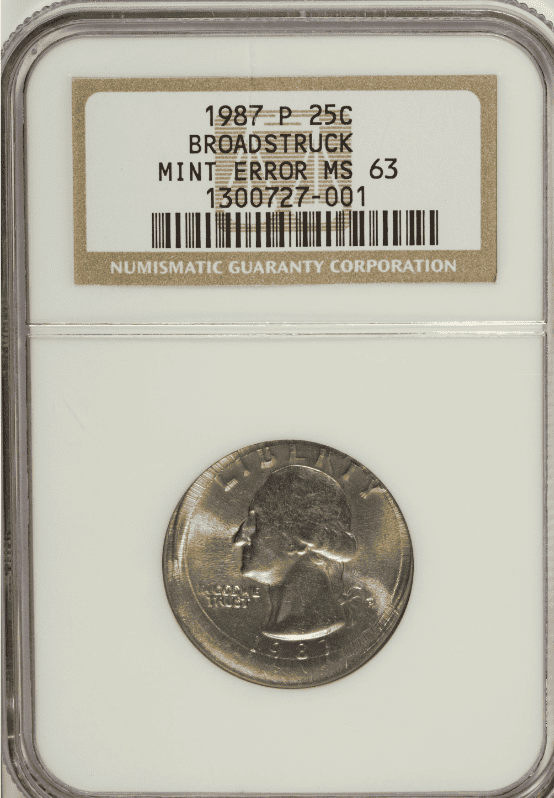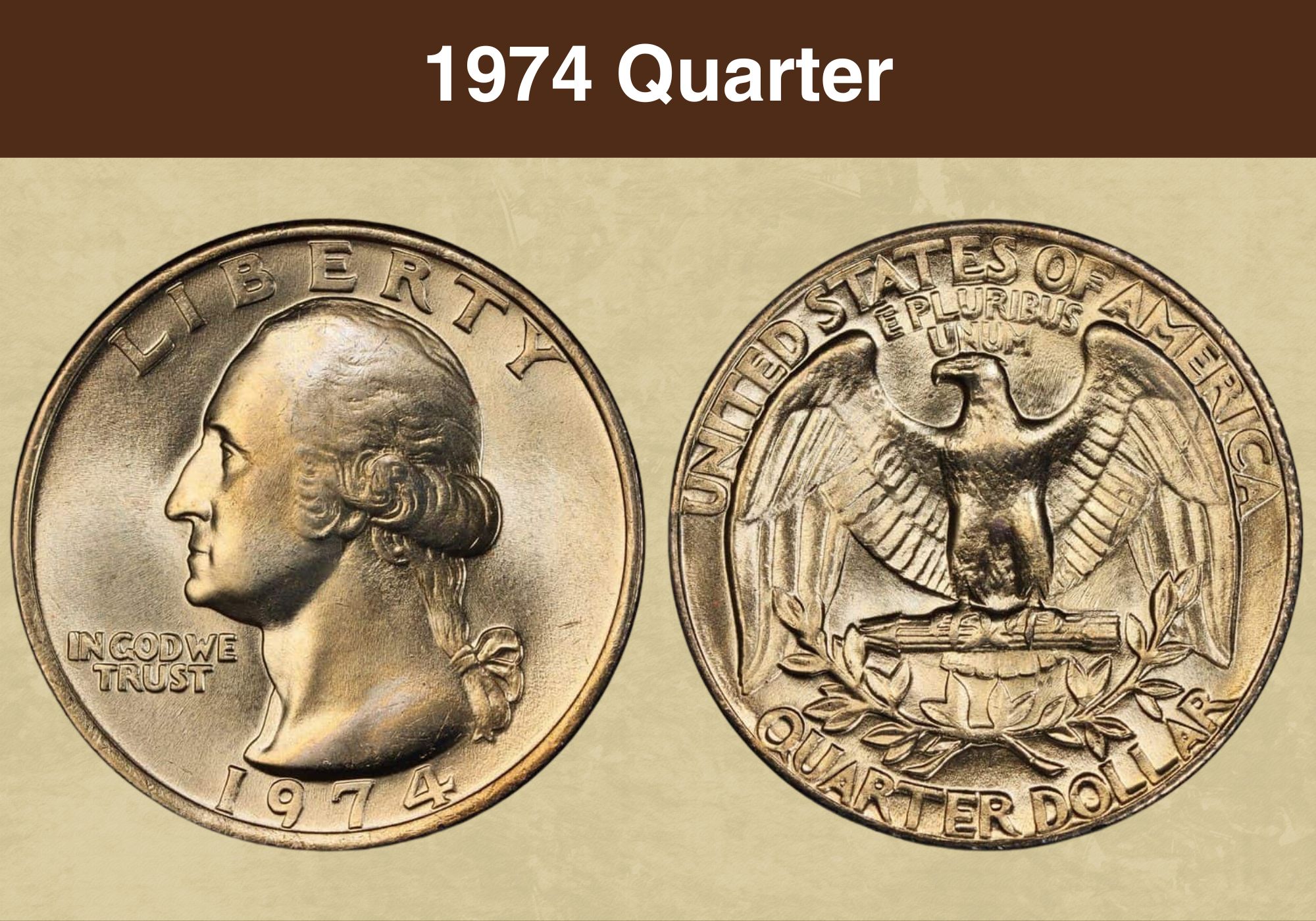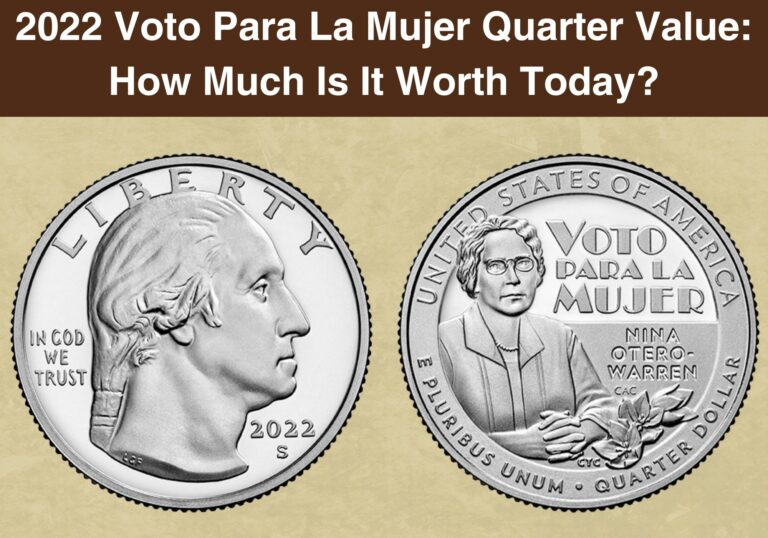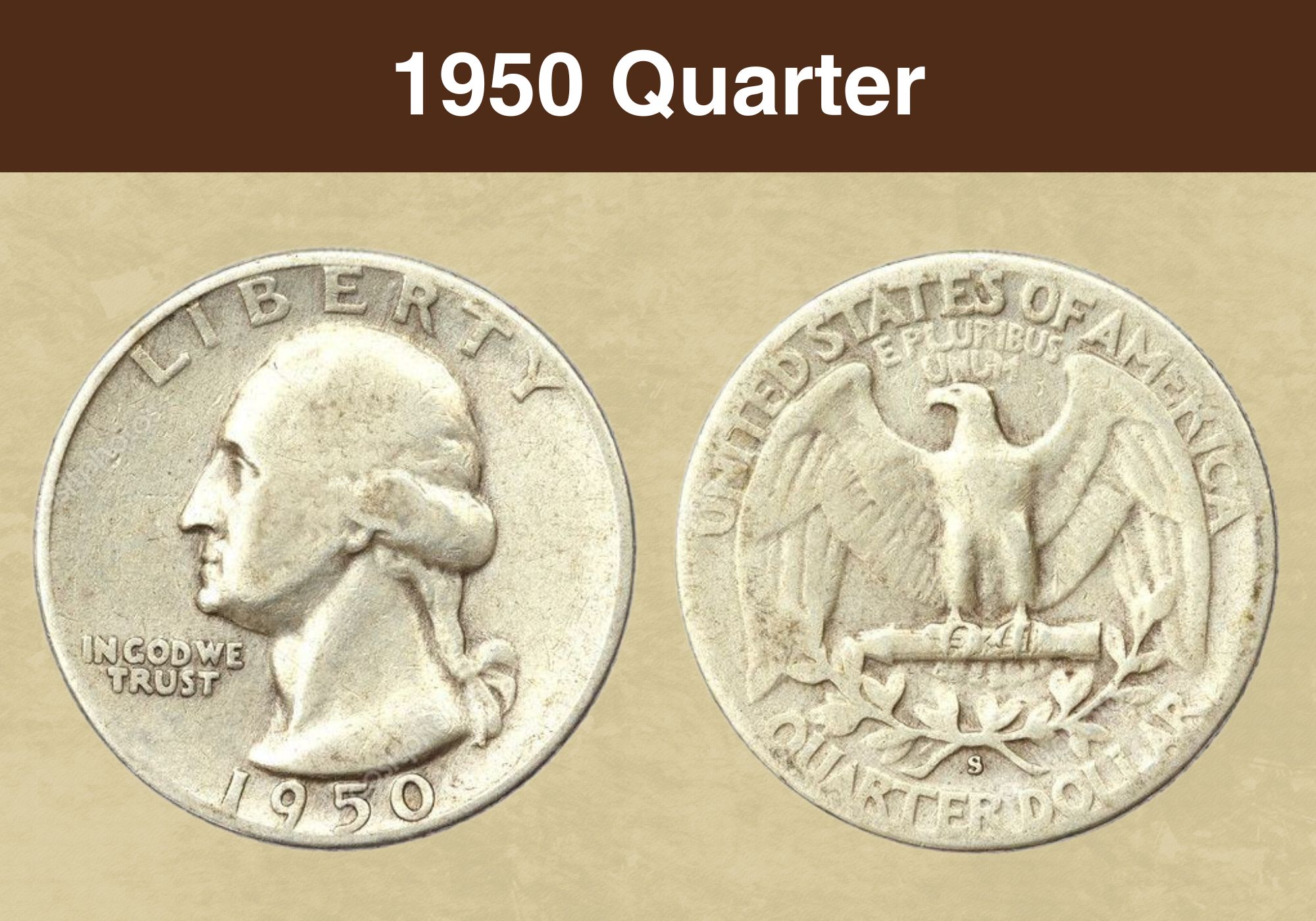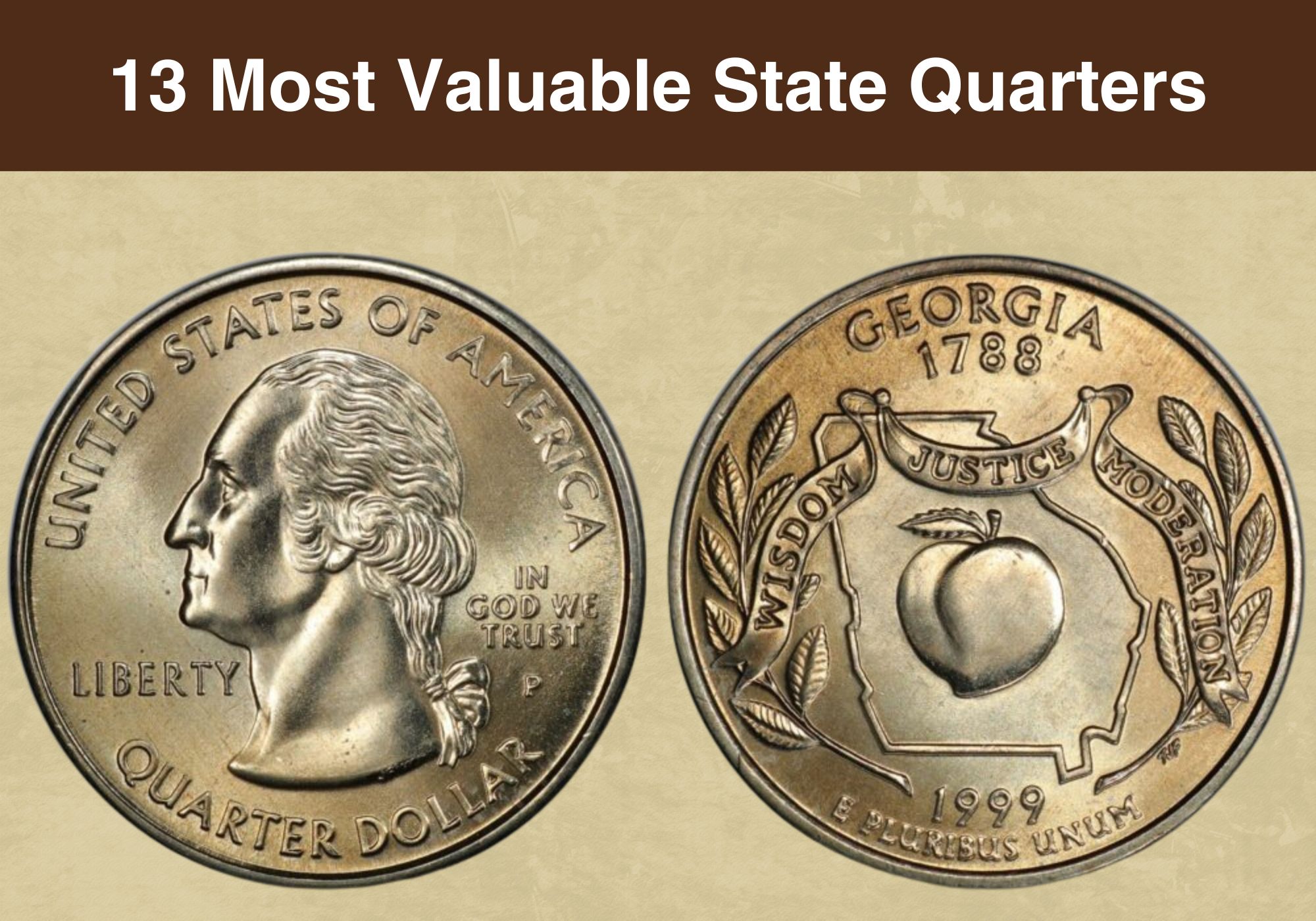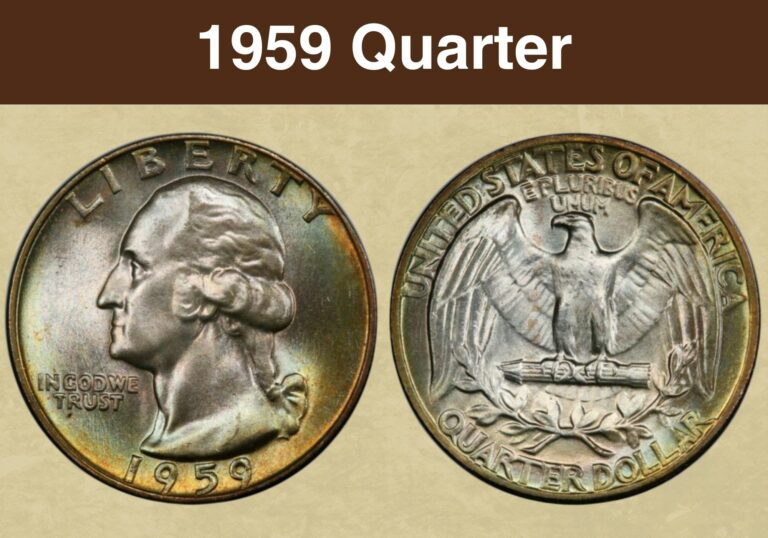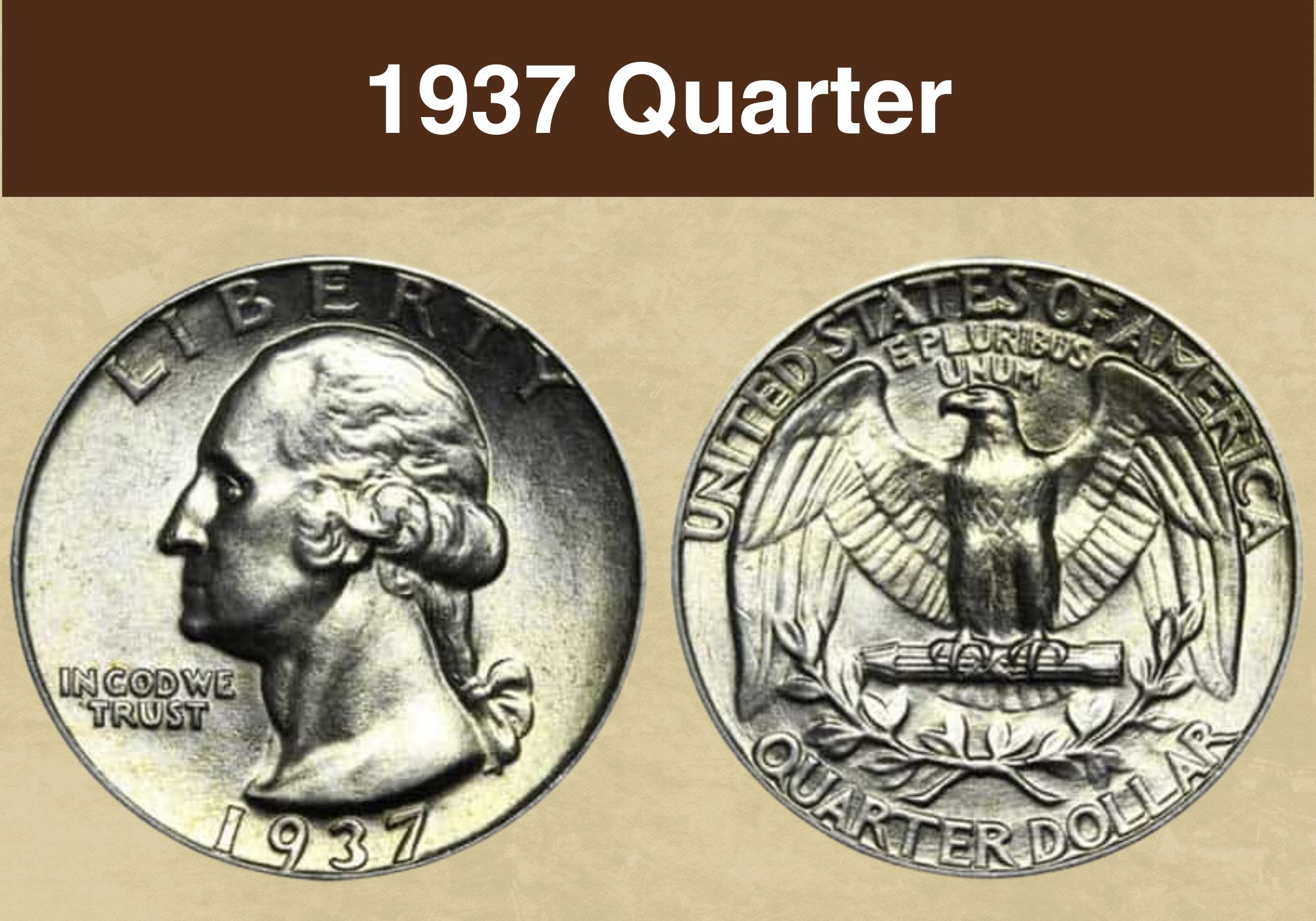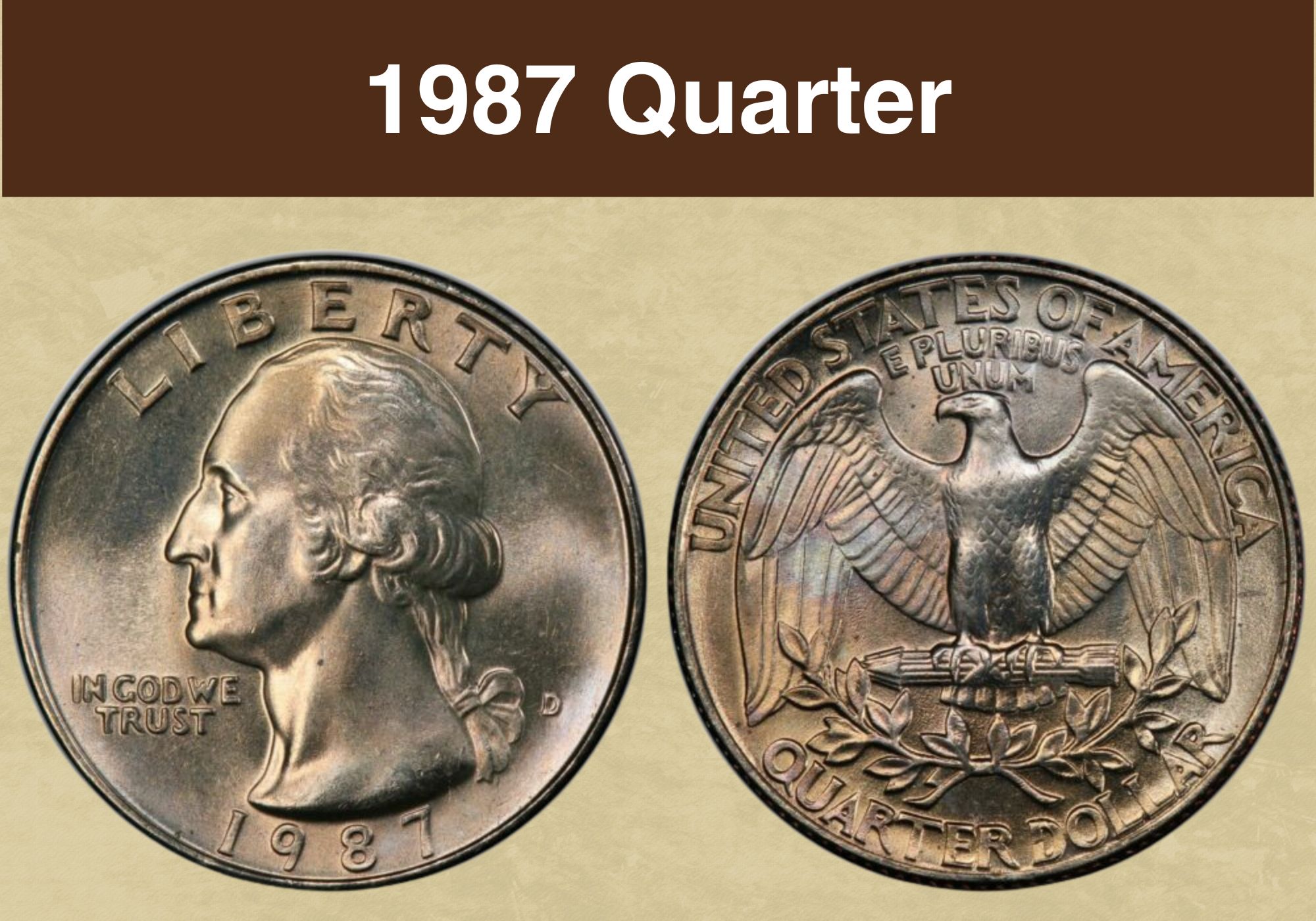
Coin Value Contents Table
Have you found a quarter dated 1987 in your pocket change? If so, you might be wondering what it’s worth. And you’ve come to the right place to find out!
We’re going to look at the 1987 quarter value. We’ll investigate why some coins are worth only their face value, while others change hands for hundreds of dollars. And we’ll discover some of the interesting Mint errors that add a premium to prices.
Ready to learn more? Then step this way!
1987 Quarter Value Chart |
||||
| Mintmark | XF45 | MS60 | MS65 | MS67 |
| 1987 P Quarter Value | $0.25 | $1 | $18 | $350 |
| 1987 D Quarter Value | $0.25 | $1 | $7 | $340 |
| PR61 | PR67 | PR69 | PR70 | |
| 1987 S Proof DCAM Quarter Value | $5 | $6 | $16 | $34 |
History of the 1987 Quarter
The quarters struck in 1987 are part of the series known as Washington quarters. The first of those were produced in 1932. And they get their nickname from the portrait of President George Washington which appears on the obverse.
The first Washington quarters were made mostly of silver. But as time went by, silver prices rose – and coin production costs rose with them.
The increasing silver value also meant that people started to see the coins as an investment. Soon, it was hoped, their silver content might be worth more than their 25-cent face value.
Coins that were expensive to produce and then weren’t circulating were a headache for the Treasury. So in 1965, it was decided to continue striking coins dated the previous year. This, it was hoped, would discourage people from hoarding them.
But it didn’t work, and later that year, it was decided to get rid of silver from quarters altogether. The same approach would be taken with dimes, which were facing the same problems.
The new coins still appeared silver in color, but their core was made of copper. The hue was a result of the cladding – an alloy of copper and nickel.
The new composition was considerably harder than silver, however. And that presented problems in getting a clean strike for the coins. The Mint responded by lowering the relief of the design for the quarter.
Wherever your 1987 quarter was struck, it will have a mint mark – “P” for Philadelphia, “D” for Denver, and “S” for San Francisco. But that wasn’t the case with the earliest Washington quarters.
Prior to 1968, neither San Francisco nor Denver added mint marks to their quarters. And it wasn’t until 1982 that the original Mint facility in Philadelphia added its marks to the coins.
Also read: Top 13 Most Valuable State Quarters Worth Money
Features of the 1987 Quarter
The Obverse of the 1987 Quarter
Anyone familiar with US coinage will recognise the portrait of George Washington on the obverse – or “heads” side – of the 1987 quarter. It’s the work of the artist John Flanagan, and it was appearing on quarters right up until 2022.
It wasn’t, however, the first choice for a coin to commemorate Washington. That had been a portrait by Laura Gardin Fraser – the portrait that appears on the modern “American Women” series of quarters. So what happened?
Well, the idea for a coin honoring Washington first arose in relation to the bicentenary of American independence from Britain. A Bicentenary Committee had been set up to oversee the celebrations. It was they who suggested that a Washington coin – a half dollar – should be produced for that year.
The committee went ahead with their plans and selected the portrait by Fraser for the obverse. But it was then decided that the Washington coin should instead be a permanent addition to the nation’s coinage. And rather than a half dollar, it should be a quarter.
As a permanent coin, the decision on the design now fell to the Treasury. The committee wrote to the Treasury Secretary, Andrew W. Mellon, recommending Fraser’s portrait. But he preferred the image by Flanagan.
Mellon left his post before the coins were struck, and the committee appealed to his successor, Ogden Mills. But Mills refused to reopen the matter.
The 1987 quarter has Flanagan’s portrait of Washington at its center. Above it is the word “LIBERTY”, which arches to follow the upper coin edge. The date appears at the bottom, parallel to the lower edge.
To the left of Washington is the familiar motto “IN GOD WE TRUST”, while the mint mark appears to his right.
The Reverse of the 1987 Quarter
While the obverse of the Washington quarter remained the same from 1932 until 2022, the reverse underwent regular changes.
Most of those, however, have been relatively recent. And in 1987, the quarter was still being struck with the same design that had graced the denomination for more than five decades.
Like the obverse, it was the work of John Flanagan. It showed an eagle with outstretched wings perched on a bundle of arrows, with an olive branch below.
The design provoked much public interest and speculation on its launch. The question of the eagle’s species was hotly debated, and the New York Times contacted an ornithologist for a definitive view. They concluded that it was a bald eagle, traditionally associated with the USA.
The bird takes up most of the surface area of the coin. The country name is inscribed parallel to the outer edge. And the Latin motto “E PLURIBUS UNUM” is in smaller lettering below it, and just above the eagle’s head.
The words mean “From the many, one”, and they refer to the creation of the USA as a union of states.
At the bottom of the coin is the denomination, written in full as “QUARTER DOLLAR”.
Other Features of the 1987 Quarter
The quarters struck in 1987 have a core made from pure copper. This is clad in an alloy of copper and nickel to give them their silver color.
And despite the silver tone coming from the nickel, there’s more copper than nickel in the cladding. The proportions are three quarters copper and a quarter nickel.
The coins measure 24.3 millimeters across and weigh 5.67 grams. And they have what’s known as a “reeded edge”.
Turn one on its side, and you’ll see a series of grooves running perpendicular to the coin faces. These are the reeds, and they’re formed by the collar which holds the planchet in place as it’s struck.
They were originally designed as an anti-fraud measure. In days when coins were made of precious metal, the practice of “coin clipping” – shaving metal from the edge – was commonplace. The reeded edge meant anyone could tell immediately if a coin had been clipped.
Also read: Top 16 Most Valuable Modern Quarters Worth Money
1987 Quarter Grading
| # | Grade |
|---|---|
| 1 | Basal State-1 |
| 2 | Fair |
| 3 | Very Fair |
| 4, 5, 6 | Good |
| 7, 8, 10 | Very Good |
| 12, 15 | Fine |
| 20, 30 | Very Fine |
| 40 | Extremely Fine |
| 50 | About Uncirculated |
| 60 | Mint State |
| 65 | Mint State |
| 70 | Mint State |
Please check our grading guides to know your coin scale, It’s the necessary step to know the exact value of your coin.
Check out now: How to Grade Washington Quarter?
1987 Quarter Value Guides
1987 P Quarter Value
The Philadelphia Mint facility struck almost 600 million quarters in 1987. These were all business strike coins – in other words, they were intended for everyday use.
Today, the PCGs estimates that in the region of 204 million of those coins survive. So finding one isn’t too much of a problem. And, unless they have an interesting Mint error of some kind, they won’t be worth more than their face value.
Even coins in uncirculated condition, known as “mint state”, are readily available. There are estimated to be around 61 million 1987-P quarters graded 60 or above (the coin grading scale runs from 1 to 70). And “gems” – those graded 65 and above – are thought to number over 6 million.
A 1987-P quarter graded MS60, the lowest grade for mint state coins, is worth only around a dollar. That rises to $18 at MS65.
From there, values continue to rise steadily with condition. The independent coin grading agency, the PCGS, values an example graded M66 at $55, and one at MS66+ at $85.
The finest 1987-P quarters to have come to light are graded MS67 – and here, availability drops sharply. To date, the PCGS has certified only 18 coins at this level.
The large mintage and relatively recent date, however, mean that there are likely to be more of them out there. And for that reason, they’re valued at a relatively modest $425 apiece.
1987 D Quarter Value
The Denver Mint facility produced even more 1987 quarters than Philadelphia – over 655 million. So it’s not difficult to find examples with the “D” mint mark.
In circulated condition, survivors are thought to number around 230 million. One of those will only be worth more than a quarter if they exhibit a collectible Mint error.
The number of mint state examples is estimated by the PCGS to be around 69 million. That means you won’t need to spend a lot of money to pick up a coin in a lower mint state grade.
Values start at a dollar for an MS60 example, rising to $10 at MS65+, $32 at MS66, and $75 at MS66+.
But just as with Philadelphia quarters, prices rise steeply from there. The PCGS has certified 28 coins at MS67, and values those at $340 each. And it’s certified a single coin to date at MS67+. That one is valued at $850.
1987 S Proof Quarter Value
1987 saw the San Francisco Mint facility strike over 4 million proof quarters. They didn’t produce business strike coins – so if your 1987 quarter has an “S” mint mark, it’s a proof.
Proof coins are struck on specially selected planchets using superior dies. The idea is to produce top quality coins for the collecting market.
But because they were always marketed as collectors’ pieces, most were stored away carefully after purchase. And that means that attrition rates are low. As a result, most proofs aren’t particularly valuable.
A 1987 S proof quarter graded anywhere between PR61 and PR66+ is worth around $5. Values tick up a dollar at PR67, and another dollar at PR67+. A coin graded PR68 is worth only around $10.
And even a flawless proof graded PR70 is valued by the PCGS at only $34.
Rare 1987 Quarter Errors List
1987 P Quarter, Broadstruck
A planchet should be held in place firmly by a collar as it’s struck. But if that doesn’t happen, the metal can spread out beyond its proper boundary. Coins with this kind of Mint errors are known as “broadstruck”.
One of the quarters struck in Philadelphia in 1987 had this problem. The quarter was graded MS63 by the NGC, and without the error it would have been worth only a couple of dollars. With it, however, it sold for $20 at auction.
1987 D Quarter, Struck Off-Center
Occasionally, the die and planchet aren’t properly aligned for the strike. When that happens, the coin is struck off-center, meaning the design will disappear off the edge. There’ll also be a blank area where the planchet wasn’t struck at all.
The value of off-center strikes tends to increase the more dramatic they are.
One quarter struck in 1987 in Denver had this type of error. It was struck about 25 per cent off-center, and had been certified by the coin graders ANACS at MS65. It sold at auction for $45.
This YouTube video from Couch Collectibles provides more information on Mint errors amongst 1987 quarters. And it also looks at a number of other valuable quarters from different mintages.
Also read: 17 Most Valuable Quarter Errors Worth Money
Where to Sell Your 1987 Quarter ?
Now that you know the value of your coins, do you know where to sell those coins online easily? Don’t worry, I’ve compiled a list of these sites, including their introduction, pros, and cons.
Check out now: Best Places To Sell Coins Online (Pros & Cons)
FAQs
How much is a quarter worth from 1987?
That depends on its condition, its mint mark, and on whether it has an interesting error.
In circulated condition, coins with a “P” or “D” mint mark will usually be worth only their face value.
But with Mint errors, they can be worth much more. A mated pair of 1987 quarters – two coins that entered the machine together and were struck at the same time – graded AU58 sold at auction for over $400.
Coins with an “S” mint mark range in value from a few dollars up to around $70 for a flawless example.
How much is an uncirculated 1987 quarter worth?
At lower mint state grades, values are similar for 1987 quarters with any mint mark.
At MS60, a Denver or Philly quarter is worth around a dollar. You might get a couple of dollars more for a PR60 San Francisco proof quarter.
At MS65, a 1987-D quarter is worth around $7. A 1987-S proof graded PR65 is worth a little less, around $5. And a 1987-P quarter is worth more, around $20.
There’s much wider variation for the best-in-class coins.
For a 1987-S proof, a perfect PR70 coin is worth only around $34. For the 1987-P, the top grade found to date is MS67, and a coin at that level is valued at $425. For the 1987-D, the top grade is MS67+. A single coin has been certified at that level, and it’s valued at $850.

